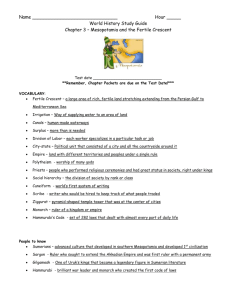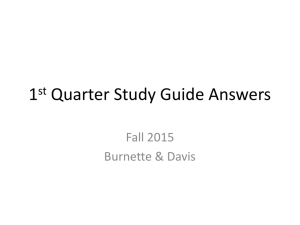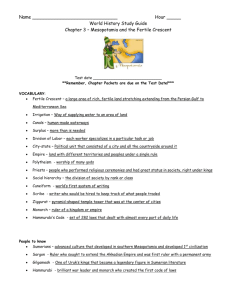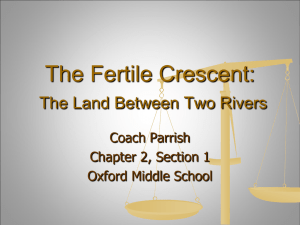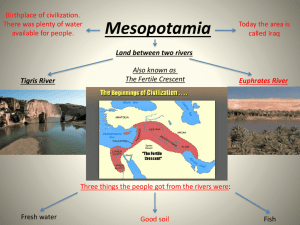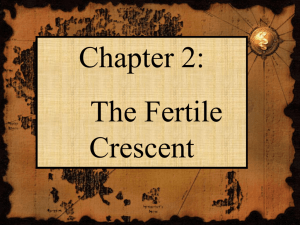Ancient Mesopotamia: Sumer, Babylon, Assyria - History Overview
advertisement
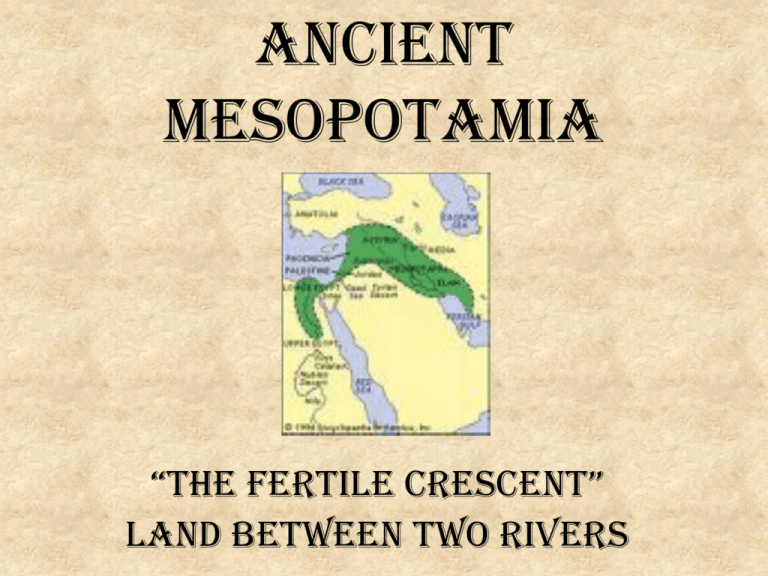
Ancient Mesopotamia “The FerTile CresCenT” Land Between Two Rivers Section 1 MESOPOTAMIA 1. Sumer ancient Sumer’s city-states (3000 B.C. - 1800 B.C.) 2. Babylonia Babylonian Empire ( 1800 B.C. - 1200 B.C.) 3. Assyria Assyrian Empire (1200 B.C. - 539 B.C.) 1. What two rivers run through the Fertile Crescent? Tigris & Euphrates Rivers 2. What body of water do the two rivers flow into? Persian Gulf 3. In what present day country is Mesopotamia located? Iraq *NOTES* ANCIENT MESOPOTAMIA “land in between the rivers” Why was this a perfect place for the 1st civilization? 1. Fertile Crescent - large arc of fertile land in the Middle East 2. Tigris & Euphrates Rivers made it possible for farming because they deposited silt in the area. 3. Cattle, pigs, goats & sheep were accessible *NOTES* WHAT CHALLENGES DID PEOPLE FACE IN MESOPOTAMIA? 1. Unpredictable floods destroyed crops, homes & people 2. Some areas were marshy and unsuitable for farming 3. This land was vulnerable to attack and invasion Farming & Cities Controlling Water Food Surplus • Used irrigation to solve their problems. • Built canals canals to water their fields and levees at the river banks to help control flooding. • Irrigation increased amount of food farmers were able to grow = surplus. • Fewer people now needed to farm, so they were free to do other jobs = division of labor. Appearance of Cities • Having people available to work on different jobs, meant that society could accomplish more large projects like building cities. • Settlements gradually developed into cities between 4000 – 3000 BC. The invention of Agriculture changed the way people lived. • Agriculture (Farming) • Growth of Cities • Division of Labor (Specialization) • Trade SUMERIAN ECONOMY • Make, sell or barter (trade) goods • Trade helped expand cities • Development of money over time Section 2 The earliest known people of the Fertile Crescent were the Sumerians. They lived in southern Mesopotamia in a number of independent citystates. City States Each consisted of a small city and its surrounding area. The rulers of these city-states constantly warred with one another for control of land and water. For protection, people turned to courageous and resourceful war leaders. Dominant city-states: Kish, Uruk, Ur. The ruler was responsible for maintaining the city walls and the irrigation systems. He led armies in war and enforced the laws. The ruler also had religious duties. He was seen as the chief servant of the gods and led ceremonies designed to please them. Rise of the Akkadian Empire • These people were not Sumerian. They spoke a different language. Akkadians lived North of Sumer and were at peace with Sumer for many years. • Peace broken by Sargon in 2300s B.C. He was the 1st ruler to have a permanent army, and used them to conquer all of the Sumerian citystates and all Northern Mesopotamia, establishing the world’s 1st empire that stretched from the Persian Gulf – Mediterranean Sea. • Built new capital on the Euphrates River called Akkad (modern-day Baghdad). Sargon • He ruled for about 50 years. • A century after his death, it could not be kept safe from invaders. • Eventually, Sumerians rebuilt Ur and conquered the rest of Mesopotamia Religion • Sumerians were polytheistic, worshipping many gods. These gods were thought to control every aspect of life, especially the forces of nature. • Each city-state had its own special god or goddess to whom people prayed and offered sacrifices of animals, grain, and wine. Ziggurats were pyramid-temples that soared toward the heavens. Their sloping sides had wide steps that were sometimes planted with trees and shrubs. On top of each ziggurat stood a shrine to the chief god or goddess of the city. The Class System – Highest class: the ruling family, leading officials, priests. – Middle class: merchants, artisans, and scribes. – Lower class: majority of people who were peasant farmers. Some had their own land, but most worked land belonging to the king or temples. – Sumerians also owned slaves. Most slaves had been captured in war. Some had sold themselves into slavery to pay their debts. But once they paid the debt, their masters had to set them free. Men & Women in Sumer • Men held political power & made laws. • Women took care of the home and children. • Education reserved for men, but some women from the upper-classes were educated as well. • Enheduanna, daughter of Sargon, was the 1st known female writer in history. She wrote hynms to a goddess. Section 3 Cuneiform By 3200 B.C., the Sumerians had invented the earliest known form of writing called cuneiform. The Sumerians employed a sharp-pointed instrument- called a stylus - to inscribe wedge-shaped characters on soft clay tablets, which were then hardened by baking. Scribes • Scribes were society’s record keepers and served the needs of the temple, royal government and businesses. • Most scribes were children of government officials, priests and wealthy merchants. • Scribe school lasted from sunrise to sunset. • There were 600 different characters to memorize • Scribes read out loud to audiences since most people could not read. Literature A long, narrative Sumerian poem, The Epic of Gilgamesh, is one of the oldest works of literature in the world. This epic is a collection of stories about a hero named Gilgamesh. In one of these Gilgamesh travels the world in search of eternal life. On his journey, he meets the sole survivor of a great flood that destroyed the world. Sumerian Achievements • Invention of writing – Cuneiform • Literature – Epic of Gilgamesh • Technical Advances: Invented the wheel, wheeled vehicles like carts, potter’s wheel, the plow, a clock using water, first to build sewers under cities, bronze tools/weapons, makeup, and glass jewelry. Math & Science • Invented a math system based on the number 60. • Divided a circle into 360 degrees. • Divided the year into 12 months. • Calculated areas of triangles & rectangles. • Made scientific tables that listed names of thousands of animals, plants, & minerals. • Used animals, plants, & minerals to make medicine. • Documented their medical knowledge listing treatments according to symptoms & body parts. Summerian Arts Architecture • Built palaces, 2 and 1 story homes. • Built Ziggurats as temples. Art • Beautiful sculptures & pottery. • Jewlery • Most famous for cylinder seals. • Musicians played instruments. Section 4 hammurabi’s Code • Hammurabi was the king of the city-state of Babylon. About 1800BC, Hammurabi conquered the nearby city-states and created the kingdom of Babylonia. • The Code of Hammurabi were laws engraved in stone and placed in a public location. Hammurabi required that people be responsible for their actions. • Some of Hammurabi’s laws were based on the principle “An eye for an eye, a tooth for a tooth.”

